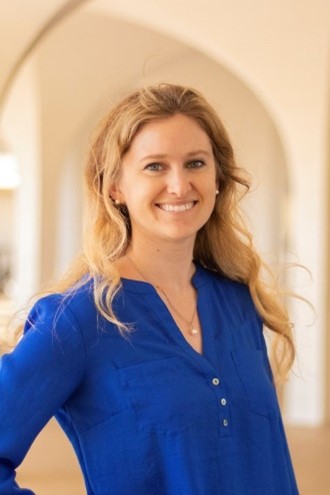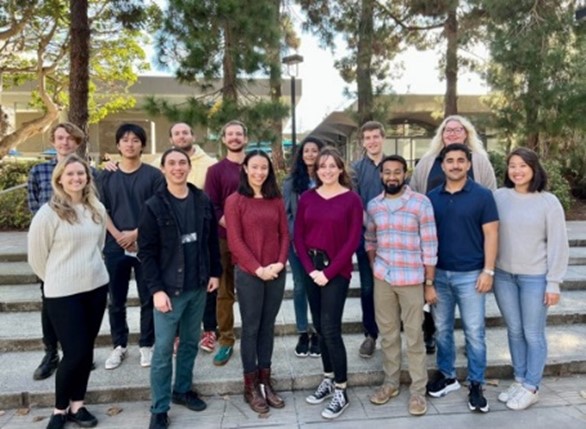
“DNA is an amazingly beautiful molecule, and it’s so important. Each of our cells has only one copy of DNA, and if it gets damaged, that messes up everything else in the cell,” says Alexis Komor, Ph.D., an assistant professor of chemistry and biochemistry at the University of California, San Diego (UCSD). Check out the highlights of our interview with Dr. Komor to learn about her scientific journey, research on DNA, and advice for students.
Q: How did you decide to study chemistry?
A: I really enjoyed math and science in middle and high school. When I applied to college, I knew I wanted to major in science over math because I felt like it was more relevant to what we experience on a day-to-day basis. I ultimately went into chemistry for a silly reason, but looking back now, I’m so very grateful that I did. Chemistry has this nice balance because it allows you to not only understand how things work on a molecular level but also see how those molecular workings relate to everyday phenomena—for example, understanding how DNA damage on a molecular level can lead to negative health outcomes.
Q: What was your path to becoming a scientist?
A: When I started college at the University of California, Berkeley, my older brother, who’s also in science, told me it was important to get an undergraduate research position. I ended up in the lab of Dr. Chris Chang working with a grad student on an inorganic chemistry project. I was incredibly grateful for the opportunity and all the skills that I learned, but I ultimately realized I wanted to work on more biologically relevant research projects.
When I applied to Ph.D. programs, I was hesitant to start researching something completely new, but I knew that I wanted to get more into the chemical biology field and to work for a woman. I was thankful to find Dr. Jackie Barton doing research in the field of bioinorganic chemistry at the California Institute of Technology. For my Ph.D., I worked in her lab making small metal-based compounds that would bind to sites of DNA damage.
Q: What were your next steps?
A: When I was about to graduate, I started looking for a postdoc position. I wanted to focus more on biology but maintain a chemical perspective on it. I was nervous about branching out because most people want to hire postdocs who will hit the ground running. I applied to work with Dr. David Liu because he had been trained as a chemist and then branched out into protein engineering, so I thought maybe he would see a little bit of himself in me. He made me an offer, and I went to his lab at the Broad Institute of MIT and Harvard.

I had come up with this crazy idea called base editing. It involved taking a DNA base and doing a very small chemical reaction on it to change it to a different base in a more efficient and precise way than other genome-editing methods. But at the beginning of my postdoc, I didn’t know how to do the lab techniques I needed for my project. Luckily, I made friends with people who did know them, and they trained me. When I finally got the project to work and we published it, Dr. Liu said, “This is a big paper. All eyes are on you, and you should apply for faculty positions.” So, I did, and I ended up getting the position I have now at UCSD.
Q: What’s your lab focusing on?
A: My lab wants to better understand how variations in our DNA impact our health. Each person’s DNA sequence is different. A lot of those variations simply contribute to different traits, but there are also those that have negative health effects. Researchers have discovered hundreds of millions of ways in which our genomes can differ, but we know the health impacts of less than 1 percent of them. My lab takes variations of interest and studies them in cell models. Previous work in this field has focused on variations associated with people of European ancestry, but my lab aims to study those from people of all backgrounds.
Q: How has NIGMS supported you?

A: It started when I was a postdoc and got an F32 fellowship. That was the first time I had to write a real grant proposal, and it made me take a few steps back and really think about what I wanted to focus on in the long term. Then when I started my lab, I got an R21 technology development grant to develop more tools in the genome-editing field. It really boosted my self-esteem, and the students were very excited, too, because we got our first big grant. After that, I applied to the Maximizing Investigators’ Research Award (MIRA) program. Once I received the MIRA, I also got supplements to support two of my students. One was a diversity supplement for a student from an economically disadvantaged background, and another was for an undergraduate student’s summer research experience. My lab wouldn’t be what it is now without the MIRA grant!
Q: What goals do you hope to achieve with your career?
A: I want to make interesting contributions to the field and help people better understand genetic diversity. I’m being very general because things always change—we have to see what we discover and then follow those results. Maybe they’ll lead us in a new direction.
I also want to make sure my trainees have successful careers. I take my mentoring very, very seriously. I want everybody who comes into my lab to get great training, become independent scientists, and go on to do amazing things.
Q: What advice would you give students who are interested in pursuing a career in science?
A: Go for it! And don’t worry if there are some science classes that you don’t like. There are so many different fields within science—you just have to figure out what’s most interesting to you. I get excited about nucleic acid chemistry and developing new ways to manipulate DNA. Try different things until you figure out what gets you really excited.
Dr. Komor’s research is supported by NIGMS grant R35GM138317.


